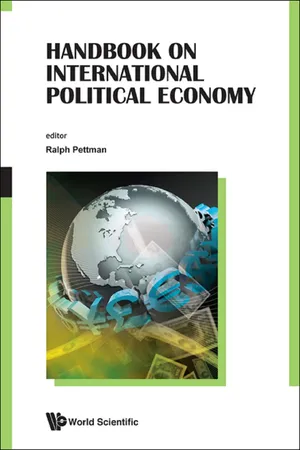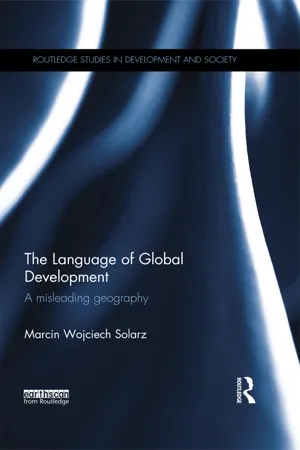History
North-South Divide
The North-South Divide refers to the economic and social differences between the developed, industrialized countries of the Northern Hemisphere and the less developed countries of the Southern Hemisphere. This divide has its roots in colonialism and has been perpetuated by factors such as unequal trade relationships, debt, and lack of access to resources and technology.
Written by Perlego with AI-assistance
Related key terms
5 Key excerpts on "North-South Divide"
- eBook - ePub
- Ralph Pettman(Author)
- 2012(Publication Date)
- WSPC(Publisher)
Part FourGlobalisation and the North/South Divide
Passage contains an image
CHAPTER 15
Globalisation and the North/SouthDivide: An Overview
Thomas W. D. DavisUniversity of Melbourne‘North’ and ‘South’ have been established terms of use in debates about international political economy since the 1960s. In their most basic form the terms are regarded as a shorthand for distinguishing ‘rich countries’ from ‘poor countries’. ‘The North’ is taken to include the industrialised, high-per-capita income, national political economies of which the majority are located in the Northern Hemisphere. ‘The South’ describes those countries with high levels of poverty and comparatively low levels of industrialisation, large numbers of which exist in the Southern Hemisphere.There are significant exceptions to this simplistic geographic demarcation. Australia and New Zealand, which are both high-income, developed political economies, are located in the ‘deep south’ of the Southern Hemisphere; meanwhile, a plethora of low-income, developing countries are found north of the equator.A purely geographic interpretation of ‘North’ and ‘South’ belies a richer conceptual history, therefore, where the ‘North-South Divide’, from the late 1960s to the early 1980s, challenged the ‘East-West’ bipolarity of the Cold War as an organ-ising principle of international relations and international political economy. While the North-South distinction continues to be employed, long after the East-West divide has fallen from use, there is some question, addressed in this chapter, as to its contemporary relevance to the current global situation.In its first iteration, the ‘North-South Divide’ attempted to describe a deep international political and economic division rather than an accurate map of global poverty. Its proponents argued that one set of countries, the former colonial powers based in the North, had established, and then unequally benefited from, the structures and institutions of international politics and global capitalism, and had little interest in remedying that inequality in order to reduce poverty in the South. - eBook - ePub
- Marcin Solarz(Author)
- 2014(Publication Date)
- Routledge(Publisher)
The conceptualization of the general division of the world into areas of high and low development in the form of the ‘North’ and ‘South’ terminological pair, and then the popularization of this way of dividing geographical space, were probably, in large measure, the result of certain compass oppositions well known for a long time in the field of socio-economic geography. They formed the empirical foundations for generalized statements about North and South or, at least, and no less importantly, provided a minimal intellectual alibi that was necessary because the general model of wealthy North/poor South was always (even when, in the days before the model became globalized, it only applied to Europe) burdened by exceptions for which it could not account (Samsonowicz 1999). Among the most widely known European developmental juxtapostions constructed according to a North–South pattern are the contrasts in Italy between the developed North and backward South (Il Mezzogiorno) and in Spain between wealthy Catalonia and poor Andalusia (and, in simple terms, even the rest of the country) (Mączak 2003). In both cases, the differences in levels of development gave rise to separatist movements. Among non-European examples of this phenomenon, the most important was the division at the time of the American Civil War in the second half of the nineteenth century between the industrializing (and therefore modern) North and the slavery- and plantation-based (and thus anachronistic) South. (In the USA, such terms as ‘frostbelt’ and ‘sunbelt’ were also promoted to contrast north-east and south-west with regard to differences in basic development tendencies, and today they are used to designate North–South opposition (also in other language versions, e.g. ‘régions du gel’ and ‘régions du soleil’) (Grzeszczak 1995).) Furthermore, Britain, the cradle of modernity, is located to the north of many of the European countries, including more or less the whole of Western Europe (and, symbolically, the whole continent). It should, however, be noted that within Britain itself, the South is more developed than the North (in relation to British internal development divisions, the expression ‘North–South divide’ is also used (Grzeszczak 1995)). Thus, as can be argued from the case of Britain, it is not true that geographical north always is and must be synonymous with wealth, and south with poverty. This is also confirmed by certain historical examples, such as Spain, France and Italy during the Middle Ages (Vilar 1986; Mączak 2003; Boyd 2004). The formula of a contemporary ‘rich north/poor south’ development division on a pan-European scale and with reference to the individual states and regions of Europe is also controversial since it is sometimes true (e.g. in Italy), and sometimes not (e.g. in Germany) (Grzeszczak 1995), or its real importance is doubtful (e.g. in light of the development contrast between Western and Eastern Europe or the Western and Eastern European members of the European Union). The case of Germany (which has its own terminology relating to its internal development inequalities: ‘Nord-Süd-Gefälle’, ‘Süd-Nord-Gefälle’ or ‘Nord-Süd-Drift’ (Grzeszczak 1995)) merits separate attention as it seems to have been particularly important in the popularization of the model of a spatial division between a more developed north and a less developed south – but, as mentioned above, whether Germany does, in fact, provide evidence for this has always been debatable (Grzeszczak 1995; Samsonowicz 1999; Cantoni 2009; Thompson 2009). - eBook - ePub
Northern Exposure
COVID-19 and Regional Inequalities in Health and Wealth
- Clare Bambra, Luke Munford, Sam Khavandi, Natalie Bennett(Authors)
- 2023(Publication Date)
- Policy Press(Publisher)
The North therefore typified the problems (and benefits) of industrialisation while the South became associated with rurality and the ‘rural idyll’. 2 However, defining the North today is not an uncontroversial task as there are longstanding (and sometimes heated) debates both in academia and among the wider public about where the North is: it has variously been conceptualised as the kingdom of Northumbria, the Humber-Mersey line, the Wash-Severn line, the historical Seven County North (comprising Cheshire, Cumberland, Durham, Lancashire, Northumberland, Westmorland and Yorkshire), the Lowry line or the Administrative North (Bambra, 2016) (Figure 1.1). When reporting data, government agencies divide England into nine regions (North East, North West, Yorkshire and The Humber, South East, the East and West Midlands, the East of England, the South West, and London). The three most northerly of these (North East, North West, Yorkshire, and The Humber) form the so-called Administrative North. We use this three-region definition of the North – partly from a practical perspective (in terms of government data) but also because the Administrative North broadly matches the more colloquial definitions of the North – the Anglo-Saxon kingdom of Northumbria, the Humber-Mersey line and the Seven-County North (Russell, 2004). While not a distinct geopolitical unit today (unlike Scotland or Wales), arguably, there is a longstanding cultural, economic, social – and political – Northern identity (Russell, 2004). The ‘North-South Divide’ has a strong cultural salience today in England – often featuring in popular narratives and discussions. This is because it is part of the longstanding and widely held perception of the North and the South of England as two different countries, two different types of England – divided economically, socially, environmentally, and culturally (Russell, 2004 ; Dorling, 2011) - eBook - ePub
India Migration Report 2022
Health Professionals' Migration
- S. Irudaya Rajan, S. Irudaya Rajan(Authors)
- 2022(Publication Date)
- Routledge India(Publisher)
Southern Interpretations of a Northern Discourse Themrise KhanDOI: 10.4324/9781003315124-12Introduction
It is hard to recall when I was first introduced to the term “Global South”.1 Perhaps, it was during the early days of my career as a development practitioner in Pakistan in the late 1990s. Or, perhaps, it was during my Master’s degree at the beginning of this century in the UK. But to suddenly realize, indeed, to be told that I and others like myself had been slotted into a geography nearly half the size of the earth, simply by virtue of our developmental and financially humble origins, was an irony that was not lost on me.Subsequently, this term and its more powerful counterpart, the “Global North”, have become indelible in the context of discussions on inequality and power structures around the world. I too, as a development practitioner and migration researcher, have used both terms liberally over the years to juxtapose my research into development, inequality and migration against a more “global” context.But, by dividing the globe across its horizontal axis, into two halves – upper and lower – scholars, academics and practitioners, have also divided their understanding of these two worlds. The upper half is consistently defined as on the path to progress and wealth, while the lower half is on an inevitable downward trajectory of inequality and disparity. And never the twain shall meet.This framing has had a marked impact on not only how countries view each other across this divide, but also on how socio-economic and political relationships are defined amongst them.2 None is more contentious than migration.Migration has traditionally been viewed in both academic and intellectual literature as a movement from the “marginalized” South to the “prosperous” North.3 - eBook - ePub
Cases in Critical Cross-Cultural Management
An Intersectional Approach to Culture
- Jasmin Mahadevan, Henriett Primecz, Laurence Romani, Jasmin Mahadevan, Henriett Primecz, Laurence Romani(Authors)
- 2019(Publication Date)
- Routledge(Publisher)
Specifically, international development projects involve the cross-cultural cooperation between organizations and individuals from developed countries (‘the Global North’) and from developing countries (‘the Global South’). The terms Global North and Global South refer to the observation that those countries that rate the highest on development indexes—e.g., education, income, life expectancy—are mostly located in the Northern Hemisphere, whereas those countries that rate lower, tend to be located in the Southern Hemisphere. However, there is more to these terms. For instance, the countries of the ‘Global North’ are often the former colonial powers, whereas the ‘Global South’ is comprised largely of former colonial territories. In terms of culture, there is also the idea that the countries of the Global North are implicitly ‘Western’, in contrast to the presumably ‘non-Western’ regions of the Global South (Mahadevan, 2017: 121). The aforementioned hierarchies are thus partly ‘real’ (economic indicators of development) and partly rooted in commonly held ideas about the world—for instance, the assumption that ‘Western culture’ as implicitly ‘developed’ (Jackson, 2013; Primecz et al., 2016).From the aforementioned perspective, we should view certain aspects of the international development sector as problematic. Although many development projects can have an immediate impact on improving the livelihood of the beneficiary communities, scholars who are critical of the development sector highlight how development aid has its own perils. For instance, it is argued that the foreign aid is unsustainable since it creates a chain of dependencies (Cardoso, 1982). In particular, post-colonial research—the academic study of the cultural legacy of colonialism and imperialism—maintains that the discourse of development has depicted an image of the South as backward, and a part of an inferior culture ‘whose deficit can only be compensated by taking over Western ideas of rationality, productivity and modernity’ (Ziai, 2016: 31). This literature has also discussed that the discourse of development can and will recreate hierarchies between North and South which can be seen as the continuation of the colonial economic regime (Escobar, 2011; Ferguson, 1990).These hierarchies between North and South can also be reproduced in development projects, as they are funded by powerful donor organizations in the North which have their own perspectives on development. This has implications on what is perceived as legitimate knowledge (Mahadevan, 2017), which in turn could reinforce existing hierarchies. Postmodern and post-colonial thinkers have discussed the close relationship between power and knowledge extensively (e.g. Foucault and Gordon, 1980; Bhabha, 1994; Frenkel, 2008). Their argument is that existing relations of power render certain discourses (e.g., the expression of a set of ideas) possible, which in turn support a certain regime of truth or a certain knowledge claim. They also argue that knowledge created within a dominant discourse is likely to engender and support relations of power (Foucault, 1978: 97). These scholars further maintain that such power imbalances are normalised through the working practices that are accepted as a part of the normal discourse and therefore often remain invisible and rarely addressed. Despite the crucial importance of these matters, we know little about how these structural power asymmetries are reproduced at the micro level in development projects and how it affects the work practices in multicultural teams or the difficulties of addressing these issues at the micro level. To help answer these questions, I present a case study of a rare incident in which such implicit power asymmetries were openly discussed in an international development project. I analyse this event with the help of Clegg’s (1989) ‘frameworks of power’, which suggests that power effects and how they are experienced are shaped by intersecting flows of power, namely structure, rules of practices and agency.
Index pages curate the most relevant extracts from our library of academic textbooks. They’ve been created using an in-house natural language model (NLM), each adding context and meaning to key research topics.




